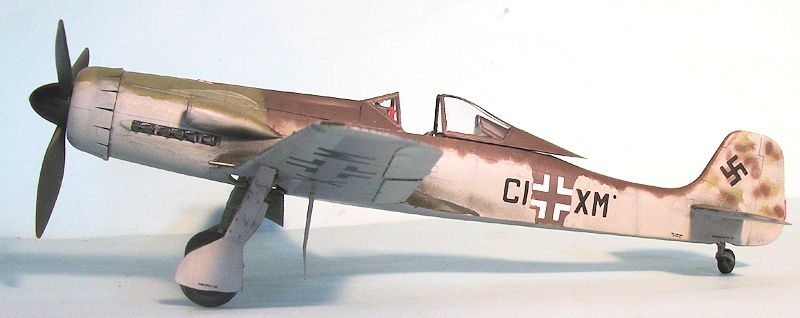
Hobby Boss 1/48 Ta-152C-0
| KIT #: | 81701 |
| PRICE: | $2400 yen at HLJ |
| DECALS: | Two options |
| REVIEWER: | Tom Cleaver |
| NOTES: |

| HISTORY |
The Focke‑Wulf
Fw‑190 had been plagued from the outset with a lack of high altitude
performance, a situation that led to the continued development of the Bf‑109
series past its development peak, due to the fact it had outstanding high
altitude performance, which became more and more necessary as the Eighth Air
Force in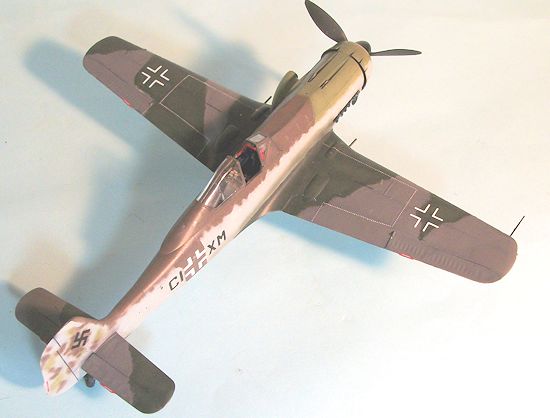 creased in size and effectiveness with its high altitude daylight
assault on Germany.
creased in size and effectiveness with its high altitude daylight
assault on Germany.
The Dora‑9,
powered by the Junkers Jumo 213A ‑ a bomber engine ‑ went some distance in
solving the problem of high altitude performance, but the airplane still lost
power above 25,000 feet, which was just the altitude the B‑17s and B‑24s came in
at.
Tank argued
continually with the Reichluftfartministerium
(RLM) to be allowed to put a Daimler‑Benz DB603 series engine in the
Jumo‑powered airframe, convinced that such a powerplant would provide the high
altitude performance so needed. Tank's success with the high‑altitude Ta‑152H ‑
the first of the series that carried its designer's name in its designation ‑
which was powered by the Jumo 213E, demonstrated that he was on the right track.
Finally, in
August 1944, following the failure of the Ta‑152B program, permission was
granted to adapt the Ta‑152B airframe to the DB603 series engine. Tank made a
maximum effort to bring the new type forward, utilizing as much of the B‑series
airframe as possible. Plans were afoot to commence production deliveries from
the Roland Group by April 1945.
Two Fw‑190D
prototypes were modified with DB603L engines as the Fw‑190V20/U1 and
Fw‑190V21/U1; unfortunately, the V20 was destroyed in an air raid on August 5,
1944. The V21 first flew on November 3, 1944, powered by a DB603E. In the
meantime, three Ta‑152C development aircraft, the V6, V7 and V8, were under
construction, with plans to power them with the DB603L.
The Ta‑152C-0/V6,
powered by a DB603LA engine, was otherwise similar to the Fw‑190V21, and made
its first flight on December 17, 1944, flown by Hans Sander. The Ta‑152C-0/V7
was similar, with the addition of the R‑11 all‑weather kit, thus representing
what would be the Ta‑152C‑0/R11. This aircraft first flew
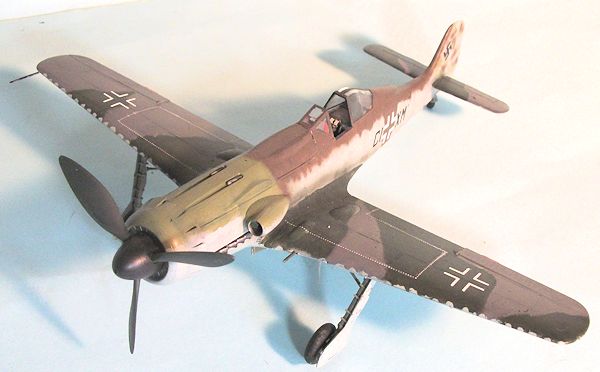 January 27, 1945,
again at the hands of Hans Sander. The Ta‑152C-0/V8, with incorporated the new Revi EZ‑42 gyro gunsight, was the development prototype of the Ta‑152C‑1, and
flew on January 14, 1945. All three had the heavy armament of a 30mm MK108
Motorkannon, two 20mm MG151s in the
upper fuselage ahead of the cockpit, and two 20mm MG151s in the wing roots.
January 27, 1945,
again at the hands of Hans Sander. The Ta‑152C-0/V8, with incorporated the new Revi EZ‑42 gyro gunsight, was the development prototype of the Ta‑152C‑1, and
flew on January 14, 1945. All three had the heavy armament of a 30mm MK108
Motorkannon, two 20mm MG151s in the
upper fuselage ahead of the cockpit, and two 20mm MG151s in the wing roots.
The V6 and V8
were powered by the DB603L, while the V7 was powered by the DB603EM, which
offered 1,800 h.p. at takeoff, boosted to 2,250 h.p. with MW50, an improvement
of 150 h.p. in both categories over the DB603L. The V7 was the fastest of the
three prototypes with a sea level maximum speed of 342 mph and 370 mph without
and with MW50, though at higher altitudes the DB603L provided substantially
better performance.
Unfortunately,
both the DB603EM and the DB603L required 96 octane C3 fuel, which was becoming
harder to get hold of in 1945 Germany; as a result, it was decided that the
production aircraft would be powered by the DB603LA, since this engine could use
both 87 octane B4 or the higher‑octane C3.
The production
versions would have been the Ta‑152C‑1 and Ta‑152C‑3, with the latter
substituting a 30mm MK103 for the MK108, equipped with the R11 all‑weather
equipment fit.
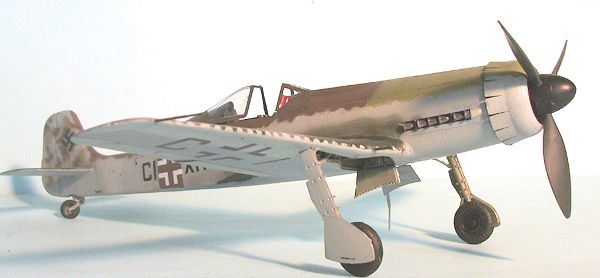 By the spring of
1945, however, Western and Soviet forces were sweeping into Germany, and there
was no more time left for development. The factories where the Ta‑152C was to be
produced were still at the component production stage when their assembly lines
were overrun.
By the spring of
1945, however, Western and Soviet forces were sweeping into Germany, and there
was no more time left for development. The factories where the Ta‑152C was to be
produced were still at the component production stage when their assembly lines
were overrun.
There can be
little doubt that, had the war lasted into 1946, the Ta‑152C would have proven a
worthy opponent to the Spitfire 22/24 and the P‑51H, which were its closest
Allied contemporaries.
Luftwaffe researcher Jerry Crandall has
unearthed a Luftwaffe Quartermeister
Report dated 20 April 1945, which shows two serviceable Ta 152 C‑1/R31s on
strength with Stab JG 301 stationed at Welzow, Werke Nummern
unknown. Unfortunately there are no known photos.
At this late date, it is most likely these airplanes -
if they were indeed there - were grounded due to lack of fuel.
It is also likely they were not given any sort of unit
markings in the last three weeks of the war.
Allied personnel likely would have mistaken them for
Fw-190D-9s after V-E Day, and their most likely disposition would have been the
scrap heap with everything else Luftwaffe.
| THE KIT |
This is the first
Ta-152C released as a mainstream injection-molded kit in 1/48.
(Actually Dragon released the
C-0
version about a year before the Hobby Boss version was issued back in early
2011. Before that was the Trimaster kit in the early 1990s with a resin wing
that is best forgotten. Ed)
Hobby Boss has since brought out the C-1 and C-11
versions, which most likely never flew.
The kit
 provides markings for the Ta-152C-0/V7 prototype
and a “whiffer” for one of the (alleged) JG 301 airplanes.
The only thing I found really wrong with the model was
that the propeller blades were too pointed; this was easily solved in a few
minutes with a sanding stick.
The model builds up as the V7 only, because while it has
two upper cowling parts it only has the supercharger intake associated with that
airframe for the DB603EM engine; the V6 airframe had a slightly different,
somewhat longer, supercharger cowling, which would probably be what the
Ta-152C-1 that might have equipped JG 301 would have looked like.
provides markings for the Ta-152C-0/V7 prototype
and a “whiffer” for one of the (alleged) JG 301 airplanes.
The only thing I found really wrong with the model was
that the propeller blades were too pointed; this was easily solved in a few
minutes with a sanding stick.
The model builds up as the V7 only, because while it has
two upper cowling parts it only has the supercharger intake associated with that
airframe for the DB603EM engine; the V6 airframe had a slightly different,
somewhat longer, supercharger cowling, which would probably be what the
Ta-152C-1 that might have equipped JG 301 would have looked like.
| CONSTRUCTION |
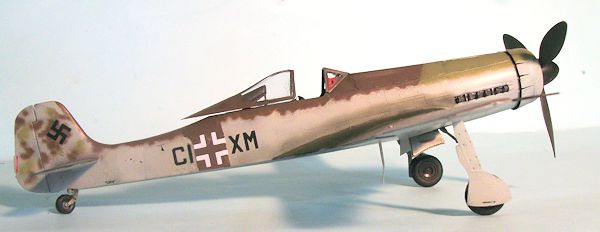 This is the first
of a series of Ta-152Cs from Hobby Boss, and it follows their philosophy of
simplicity in product design, with enough detail to satisfy an out of box model
builder.
Assembly is very straightforward and presents no difficulties.
This is the first
of a series of Ta-152Cs from Hobby Boss, and it follows their philosophy of
simplicity in product design, with enough detail to satisfy an out of box model
builder.
Assembly is very straightforward and presents no difficulties.
I assembled the model as
two sub-assemblies, the wing and the fuselage, and pre-painted all the various
small parts before assembly.
There is probably more to the engine than what Hobby
Boss has provided, but there's an engine in there and it looks OK to me.
| COLORS & MARKINGS |
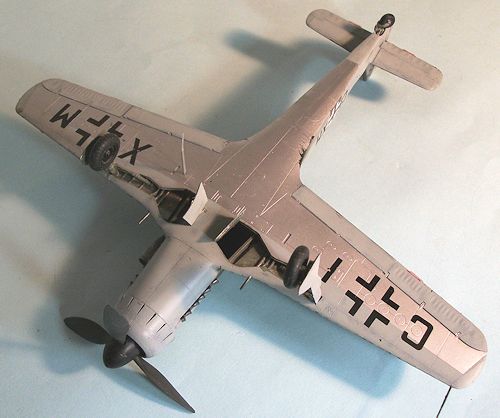 Ta-152H and some
on the pattern used for the Fw-190D-9 - either choice is valid, and I think I
ended up somewhere in the middle.
Since the 81/83 fuselage and 75/82 wing colors make a
colorful choice, that was why I went with the colors I used.
Ta-152H and some
on the pattern used for the Fw-190D-9 - either choice is valid, and I think I
ended up somewhere in the middle.
Since the 81/83 fuselage and 75/82 wing colors make a
colorful choice, that was why I went with the colors I used.
Since this
airplane likely didn't have 50 hours on it in its lifetime, I kept the airframe
clean other than to give it a heavy exhaust stain, which is shown in that one
photo and was done with Tamiya Semi-Gloss Black.
I then assembled and attached the landing gear and
attached the prop, then unmasked the canopy.
| CONCLUSIONS |
June 2013
Review kit courtesy of
HobbyLink
Japan.
Order yours at the link
If you would like your product reviewed fairly and fairly quickly, please contact the editor or see other details in the Note to Contributors.